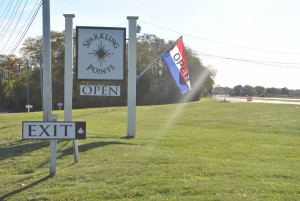
Entrance
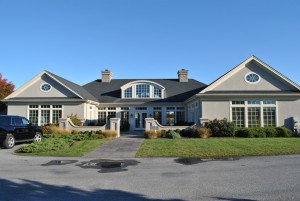
Tasting House
Choosing the right winery/vineyard in Long Island to visit for a school project is not an
easy task to do, specially if one is not familiar with the place. After countless hours of researching, I still could not find the right place. I was left with one last option―networking. I found out that one of my coworkers is from Long Island and is a wine fanatic. I also learned about a vineyard/winery which was highly recommended by our Chef de Cuisine to go to. So we found ourselves in Sparkling Pointe Winery and Vineyards at the North Fork of Long Island on a sunny Monday afternoon last October 26, 2015.
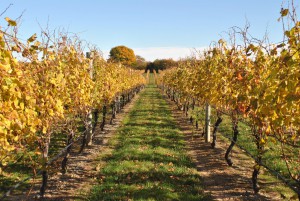
Vineyard
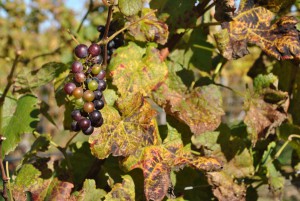
The only grape I found in the vineyard
We were welcomed by Laura Trunz, their Regional Sales Manager at their Tasting House. She seated us in their large outdoor patio area adjacent to their vineyard and gave us an overview about their establishment and why it’s unique from other vineyards/wineries in the wine region. They are the only winery specializing exclusively in sparkling wine production in Southold, Long Island. The sparklers they produce are served in top-rated Michelin starred restaurants such as Eleven Madison Park(3-stars), Aquavit(2-stars), and Gramercy Tavern(1-star). A cool to moderate maritime climate is tempered by two bodies of water, the Long Island Sound and the Atlantic Ocean, which provides long, warm summers with cooling breezes and moderate rainfall. Unique glacial soils of sandy loam provide excellent drainage. Their vineyard farms 40 acres of vines planted only with the classic champagne grape varietals: Pinot Noir, Pinot Meunier, and Chardonnay. Combined plantings consist of three clones of Dijon Chardonnay, one clone of Pinot Menuier, and 7 clones of Pinot Noir – four from Burgundy and three from Champagne. The training system is Vertical Shoot Positioning for all sites with 1250 plants per acre for high density farming with less yield per plant. The grapes are hand-harvested typically between the last week of August and the first week of September at 18 – 19 brix for exclusively Sparkling Wine production.They utilize a drip irrigation system which reduces the amount of water used by localizing the water supply to the root of the plant. They have been certified Sustainable by the Long Island Sustainable Winegrowing Organization since 2014.
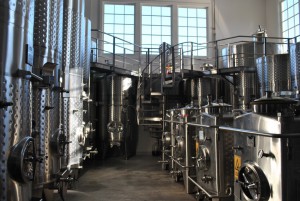
Production Facilities inside the Winery
It was unfortunate to know that they harvested their grapes early. Their vines already
turned from green to yellow. Grapes were nowhere to be seen, but I was fortunate enough to find a grape while taking pictures of their vineyard. Ms. Trunz then escorted us to their winery to show us their production facilities. It was like reading Exploring Wine all over again, but this time―reality! She showed us all the facilities they used for their wine production with a step-by-step explanation of how their wines are made. “The winery features a bladder press for gentle whole cluster pressing of the grapes, a tank room of 30,000 gallons for temperature controlled fermentations, 3,000 bottle-per-hour bottling line, 2,000 bottle gyro pallet riddling machine, fully automated disgorging line, and a well-equipped laboratory delivering daily wine analysis. A reserve room holds 1,700 gallons of base wines aged in French oak and stored in stainless steel drums. They take pride on their State of the Art Net-Zero Wine Storage Warehouse with geothermal wells and solar photovoltaic array roofing. It has been designated as the 1st Greenlogic certified Zero Energy Warehouse in New York State (Net Zero means the amount of energy used is equal to the amount of energy produced on site).” Our misfortune continued because wine production just ended when we arrived, so we didn’t have the opportunity to see their facilities in action.

NV Brut labeled with “Methode Champenoise”
After our winery tour, we went back to the tasting house and were seated by Ms. Trunz. We had a wine tasting free of charge on four of their popular sparklers. We tasted an NV Brut (38% Chardonnay, 38% Pinot Noir, 24% Reserve) , a 2006 Brut Seduction (54% Pinot Noir, 46% Chardonnay), NV Cuvée Carnaval Rouge (65% Merlot, 38% Pinot Noir, 23% Chardonnay), and lastly a CV Cuvée Carnaval Blanc (68% Pinot Noir, 26% Chardonnay, 6% Reserve). She was very knowledgeable about the wines we tasted and was able to provide tasting notes as well as food pairing for each wine. While tasting the wines, I asked to take pictures of the bottles. To my dismay, I noticed that both of the Cuvée were labeled “Methode Traditionelle“, while the Bruts were labeled “Methode Champenoise“. As a wine student, I’ve learned that “Methode Champenoise” can only be used in wines produced in Champagne, France. I then raised a question regarding what I’ve observed, and she quickly replied that there are no laws regarding the use of that labeling here in New York.
Such an unforgettable experience in a short period of time. The taste of those wines still linger in my mouth. Although it’s a struggle to figure out the taste and smell of different wines, never have I imagined that learning about them would be of my interest. Sparkling Pointe is indeed a unique gem in the North Fork of Long Island. Who doesn’t love Sparkling Wines?




I would like to say this is my favorite vineyard project .
Very nice pictures! I didn’t know there were vineyards that focuses on making sparkling wine. Very informative post. Thanks